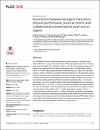Associations between biological maturation, physical performance, postural control, and mathematical achievement in youth soccer players

View/
Date
2024-03-01Author
Hermassi, SouhailKonukman, Ferman
Al-Marri, Senaid Salem
Hayes, Lawrence D.
Bartels, Thomas
Schwesig, René
...show more authors ...show less authors
Metadata
Show full item recordAbstract
This investigation explored relationships between biological maturation, physical and academic performance in young male soccer players. Thirty-eight players (age: 9.79 ± 1.21 years; body mass index (BMI): 20.4 ± 2.39 kg/m2; body fat: 16.8 ± 2.21%) participated. Measures of anthropometry used for body mass, body fat percentage (%BF), and BMI as well. Postural control, 15 m sprint, squat jumps and counter-movement jumps (SJ, CMJ), and T-half test for change-of-direction (CoD) were parameters of physical performance. The grade point average (GPA) of mathematics determined academic attainment. Moore’s equations were used to estimate their maturity status (PHV). Biological maturation was highly correlated with most (not 15 m sprint) physical and academic performance parameters, especially CMJ (r = -0.812) and mathematics (r = -0.781). Academic performance showed the largest relations to the jumping performance (CMJ: r = 0.771; SJ: r = 0.723). In contrast, anthropometric and fatness parameters were not relevantly (r ≥ 0.5) correlated with any other parameters. The largest correlations were calculated for sitting height vs. SJ (r = -0.408), sitting height vs. postural control (r = -0.355), leg length vs. postural control (r = -0.339). As a result, it is essential to take biological maturation inconsideration while assessing the physical and academic achievement of young soccer players. In consequence, soccer coaches and physical education (PE) teachers should be cognizant of the impact of biological maturity on physical and academic performance to assist fair and equal opportunities for achievement in young players.
Collections
- Physical Education [132 items ]

